Quick Summary:
- A studio website is crucial for 2026 growth.
- Costs vary; budget for design, features, and ongoing care.
- Prioritize features and choose your development partner wisely.
Table of Contents
- Why Your Studio Needs a Stellar Online Presence in 2026
- The Digital Showcase: Beyond Brick and Mortar
- Credibility and Trust: Your Digital Handshake
- Reaching New Audiences: Breaking Geographic Barriers
- Streamlining Operations: Bookings, Payments, and More
- Deconstructing Studio Website Costs: The Core Components
- Domain Name: Your Digital Address
- Website Hosting: Your Digital Land
- Website Design & Development: The Heart of Your Site
- DIY Website Builders (e.g., Squarespace, Wix, Shopify)
- Template-Based Websites (CMS like WordPress with Themes)
- Custom-Designed & Developed Websites
- Freelancer vs. Agency (Cost Implications, Quality, Support)
- Essential Features That Impact Your Studio Website Cost
- Portfolio/Gallery Integration
- Online Booking & Scheduling System
- E-commerce Functionality
- Contact Forms & CRM Integration
- Blog/News Section
- Social Media Integration
- Responsiveness & Mobile Optimization
- SEO Features & Analytics Integration
- Advanced Security Features
- Multilingual Support
- Unique Custom Functionality
- Beyond Launch: Ongoing Costs for Your Studio Website
- Website Maintenance & Updates
- SEO & Digital Marketing
- Licensing Fees
- Data Backup & Recovery Services
- SSL Certificates
- Budgeting for Your Studio Website in 2026: A Qrolic’s Guide
- The “Bare Bones” Budget (Under
,000 Initial Investment)
- The “Growth-Focused” Budget (
,000 – ,000 Initial Investment)
- The “Premium & Bespoke” Budget (,000 – ,000+ Initial Investment)
- Cost-Saving Strategies Without Compromising Quality
- Choosing the Right Partner: Freelancer vs. Agency vs. DIY
- DIY: Control & Cost Savings, But Time & Skill Investment
- Freelancers: Flexibility & Personal Touch, But Limited Scope
- Web Agencies: Comprehensive Solutions & Expertise, But Higher Cost
- What to Look For in a Web Development Partner (Freelancer or Agency)
- Qrolic Technologies: Your Partner in Crafting an Impactful Studio Website
- Who is Qrolic?
- Our Approach to Studio Websites
- Why Choose Qrolic for Your Studio
- Services Relevant to Studio Websites
- Realizing Your Vision with Qrolic
- Actionable Steps: Your Studio Website Journey in 2026
- Step 1: Define Your Goals & Audience
- Step 2: Research & Gather Inspiration
- Step 3: Outline Your Desired Features
- Step 4: Set Your Budget (Realistically)
- Step 5: Choose Your Development Path
- Step 6: Plan for Ongoing Success
- Future-Proofing Your Studio Website: Trends for 2026 and Beyond
- AI Integration
- Voice Search Optimization
- Enhanced Personalization
- Immersive Experiences (VR/AR for Tours, Virtual Classes)
- Core Web Vitals and User Experience as Paramount
- Sustainability in Web Design
- The ROI of a Professional Studio Website: It’s an Investment, Not an Expense
- Increased Bookings & Revenue
- Enhanced Brand Authority & Trust
- Operational Efficiency
- Competitive Advantage
- Final Thoughts: Your Studio’s Digital Frontier Awaits
Why Your Studio Needs a Stellar Online Presence in 2026

Imagine stepping into a beautiful, inviting studio, only to find no one knows about it online. In 2026, the digital world isn’t just an option; it’s the primary gateway for your audience to discover, engage, and ultimately choose your studio. Whether you run a vibrant dance studio, a serene yoga sanctuary, a cutting-edge music production house, a captivating Photography Studio, or a dynamic art space, your website is your most valuable asset. Understanding the studio website cost is the first step towards unlocking this potential.
The Digital Showcase: Beyond Brick and Mortar
Your studio’s website is more than just a digital brochure; it’s a living, breathing extension of your physical space. It’s where your portfolio shines, where client testimonials build trust, and where your unique vibe comes alive. For a photography studio, it’s a stunning gallery. For a dance studio, it’s a vibrant schedule and captivating video snippets. For a music studio, it’s a showcase of sound engineering prowess and artist collaborations. This online presence allows potential clients to experience your studio’s essence long before they walk through your doors, making the investment in website design for studios critical.
Credibility and Trust: Your Digital Handshake
In today’s competitive landscape, a professional website isn’t a luxury; it’s a fundamental pillar of credibility. A well-designed, functional, and up-to-date website signals professionalism and reliability. It builds immediate trust with potential clients, reassuring them that you are a legitimate, serious business. Conversely, a poor or non-existent website can raise red flags, leading potential customers to question your authenticity or capabilities. Think of it as your studio’s digital handshake – firm, confident, and welcoming.
Reaching New Audiences: Breaking Geographic Barriers
Traditional word-of-mouth is powerful, but a website amplifies your reach exponentially. With strategic SEO for studios, your website can appear in search results when someone in your area – or even across the globe – is looking for services like yours. A well-optimized studio website can attract individuals who might never have heard of you otherwise, breaking down geographic barriers and opening doors to a wider, more diverse clientele. This expanded reach directly translates to more leads and opportunities, justifying the initial studio website cost.
Streamlining Operations: Bookings, Payments, and More
Beyond marketing, your website can be a powerful operational tool. Imagine clients effortlessly booking classes or sessions online, making secure payments, or signing up for workshops – all at their convenience, 24/7. This level of automation frees up your valuable time, reduces administrative burdens, and provides a seamless, professional experience for your clients. For a Yoga Studio, easy class sign-ups are a game-changer. For a music studio, a clear booking system for studio time is essential. This operational efficiency is a hidden benefit that significantly boosts the return on your studio website cost.
Deconstructing Studio Website Costs: The Core Components

Understanding the studio website cost requires breaking it down into its fundamental building blocks. Each component plays a vital role, and the choices you make for each will significantly influence your overall investment.
Domain Name: Your Digital Address
What it is: Your domain name is your unique address on the internet (e.g., yourstudioproduction.com). It’s how people find you.
Cost: Relatively low, typically $10 – $20 per year. Premium domain names (short, highly memorable, popular keywords) can cost significantly more initially, but this is rare for most studios.
Tips:
- Keep it short, memorable, and easy to spell.
- Include your studio name or a relevant keyword.
- Opt for
.comif possible, as it’s the most recognized. Local studios might also consider.net,.org, or country-specific domains like.caor.uk. - Register it early! Your ideal name might be taken.
Website Hosting: Your Digital Land
What it is: Hosting is where your website’s files and data live on a server, making it accessible to anyone on the internet. Think of it as the plot of land your digital house sits on.
Types & Cost:
- Shared Hosting ($5 – $30/month): Most common for small to medium studios. Your website shares server resources with others. Affordable but can be slower during peak traffic.
- VPS (Virtual Private Server) Hosting ($20 – $80/month): Offers more dedicated resources and better performance than shared hosting, suitable for growing studios with higher traffic.
- Dedicated Hosting ($80 – $300+/month): Your website gets an entire server to itself. Best for very large, high-traffic studios or those requiring maximum security and performance.
- Managed wordpress Hosting ($25 – $100+/month): Specialized hosting optimized for WordPress sites, often including automatic updates, backups, and enhanced security. Ideal for many studios using WordPress.
Considerations:
- Reliability (Uptime): Aim for hosts guaranteeing 99.9% uptime.
- Speed: Fast loading times are crucial for user experience and SEO.
- Security: Look for SSL certificates (often included), firewalls, and malware scanning.
- Customer Support: Responsive support is invaluable when issues arise.
- Scalability: Can your hosting plan grow with your studio?
Website Design & Development: The Heart of Your Site
This is typically the largest component of your studio website cost, as it encompasses the visual aesthetics, functionality, and overall user experience. This area is where significant variations in professional studio website pricing occur.
DIY Website Builders (e.g., Squarespace, Wix, Shopify)
What it is: Drag-and-drop platforms that allow you to build a website without coding knowledge.
Pros:
- Lowest initial cost: Often just a monthly subscription.
- Fast setup: Get a site live quickly.
- User-friendly: No coding skills required.
- Integrated hosting: Hosting and often a free domain for the first year are included.
Cons:
- Limited customization: You’re largely restricted to their templates and features.
- Scalability issues: Can be challenging to add complex, custom functionality later.
- Vendor lock-in: Migrating away can be difficult.
- Less unique: Your site might look similar to others.
Ideal for: Small studios on a very tight budget, those needing a quick online presence, or individuals with a knack for design but no coding skills. Perfect for a basic small studio website budget.
Cost Range: $20 – $70 per month (subscription), often with higher tiers for more features or e-commerce.
Template-Based Websites (CMS like WordPress with Themes)
What it is: Using a Content Management System (CMS) like WordPress combined with pre-designed themes (templates) that you can customize. This approach gives you more flexibility than DIY builders while still leveraging existing frameworks.
Pros:
- Greater flexibility: More customization options than DIY builders.
- Vast ecosystem: Thousands of themes and plugins for every imaginable function (e.g., online booking for studios, e-commerce).
- Ownership: You own your content and can migrate hosts easily.
- SEO-friendly: WordPress is inherently good for SEO.
Cons:
- Steeper learning curve: Requires some technical familiarity or hiring help.
- Ongoing maintenance: Requires updates for security and functionality.
- Potential for “template trap”: If not customized well, can still look generic.
- Plugin dependency: Too many plugins can slow down your site.
Ideal for: Most small to medium studios that want a professional look and specific functionalities (like a strong photography studio website portfolio or dance studio website class schedule) without the custom development price tag.
Cost Range:
- Theme: $0 (free) to $150 (premium one-time).
- Plugins: $0 (free) to $100s per year (premium subscriptions).
- Development/Customization (if hiring): $1,000 – $5,000+ depending on complexity and designer/developer rates. This could involve setting up the theme, customizing CSS, installing essential plugins, and populating content.
Custom-Designed & Developed Websites
What it is: A website built from the ground up to your exact specifications, without reliance on pre-made templates. Every element, from design to functionality, is unique to your brand.
Pros:
- Unparalleled uniqueness: Reflects your brand identity perfectly.
- Complete control & scalability: Built to your specific needs, easy to expand.
- Optimized performance: Clean code leads to faster load times.
- Superior user experience: Designed precisely for your target audience.
- Strong competitive advantage: Stands out from the crowd.
Cons:
- Highest initial cost: Requires significant investment in design and coding.
- Longer development time: Takes more time to plan and build.
- Relies heavily on developer expertise: Choosing the right partner is crucial.
Ideal for: Established studios, those with unique operational needs, specific branding requirements, or ambitious growth plans. Studios that want to lead their niche and need a truly bespoke solution, often including complex e-commerce for studios or integrated custom management systems.
Cost Range: $5,000 – $20,000+, depending on complexity, features, design intricacy, and the developer/agency you choose. A sophisticated music studio website with advanced booking and demo submission features, or an art gallery with a high-end virtual tour, would fall into this category.
Freelancer vs. Agency (Cost Implications, Quality, Support)
- Freelancer: Often more affordable (hourly rates typically $50 – $150/hour or project-based). Provides a personal touch but might have limited bandwidth or specialized skills. Great for smaller projects or if you know exactly what you need.
- Web Agency: Generally higher cost (hourly rates $100 – $300+/hour or project-based). Offers a team of specialists (designers, developers, SEO experts, project managers). Provides comprehensive solutions, greater reliability, and ongoing support. Ideal for complex projects or if you want a full-service partner for your studio website design.
Essential Features That Impact Your Studio Website Cost
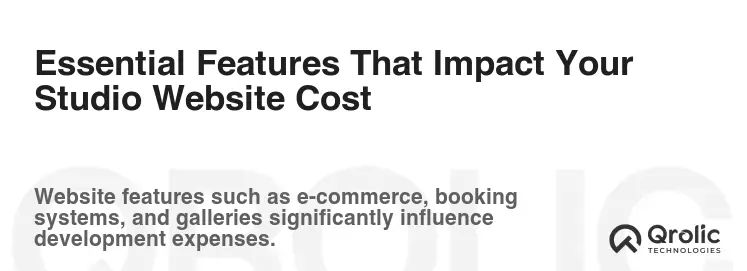
The more features you want, the higher your studio website cost will be. It’s crucial to prioritize what truly adds value to your studio and your clients.
Portfolio/Gallery Integration
What it is: A dedicated section to showcase your work, photos, videos, or student achievements. Absolutely vital for visual and performance-based studios.
Impact on Cost: Basic galleries are often included in themes. Advanced features like AJAX loading, lightbox pop-ups, categorization, search filters, password-protected client galleries (for photographers), or embedded high-definition video players will increase complexity and cost.
Online Booking & Scheduling System
What it is: Allows clients to view availability, book sessions/classes, and often make payments directly through your website. A non-negotiable for yoga studio websites, dance studio websites, and music studio websites offering time-based services.
Impact on Cost:
- Basic (free/low-cost plugins): Simple calendar integration, email notifications.
- Mid-range (premium plugins/third-party integrations): Syncs with Google Calendar, automated reminders, multiple staff/resource management, payment gateway integration, recurring bookings. Cost can be $15 – $100+/month or a one-time purchase of $50 – $200+ for the plugin.
- Custom-built: Tailored to unique workflows, complex pricing structures, loyalty programs. Significant development cost.
E-commerce Functionality
What it is: Enables you to sell products or services directly from your website – merchandise, online classes, workshops, gift cards, digital downloads, or even artwork. Critical for studios looking to diversify revenue.
Impact on Cost:
- Basic (e.g., WooCommerce for WordPress): Free core plugin, but setup, design, and payment gateway integration add cost.
- Advanced: Inventory management, shipping integration, coupon codes, customer accounts, subscription services, analytics. Each adds to development time and potentially licensing fees.
- Platform-specific (e.g., Shopify): Monthly subscription $29 – $299+ plus transaction fees.
Contact Forms & CRM Integration
What it is: Simple forms for inquiries, feedback, and newsletter sign-ups. CRM (Customer Relationship Management) integration automatically feeds these contacts into a system to manage client relationships.
Impact on Cost: Basic forms are easy. Integration with advanced CRM systems (e.g., HubSpot, Salesforce) or email marketing platforms (Mailchimp) requires additional setup and configuration.
Blog/News Section
What it is: A space to publish articles, updates, news, and behind-the-scenes content. Excellent for SEO, engaging your audience, and establishing thought leadership.
Impact on Cost: Basic blog functionality is often inherent in CMS platforms like WordPress. Content creation itself is an ongoing cost or time investment. Custom blog layouts or complex filtering might add development cost.
Social Media Integration
What it is: Links to your social profiles, social sharing buttons, and potentially embedded feeds.
Impact on Cost: Standard feature, usually minimal cost unless highly customized feeds or complex social login features are desired.
Responsiveness & Mobile Optimization
What it is: Ensures your website looks and functions perfectly on all devices – desktops, tablets, and smartphones. Absolutely non-negotiable in 2026, as most traffic comes from mobile.
Impact on Cost: Should be a standard inclusion in any professional design. If not, retrofitting can be costly. Essential for SEO, as Google prioritizes mobile-first indexing.
SEO Features & Analytics Integration
What it is: Tools and configurations that help your site rank higher in search engines and track visitor behavior.
Impact on Cost: Basic SEO features (sitemaps, meta tags, schema markup) are often built into themes/plugins. Advanced SEO for studios strategies, keyword research, content optimization, and Google Analytics/Search Console setup typically require professional input or specialized tools, adding to the total studio website cost.
Advanced Security Features
What it is: Measures to protect your site from hacks, malware, and data breaches (e.g., firewalls, regular backups, intrusion detection, two-factor authentication).
Impact on Cost: Basic SSL is often included with hosting. Premium security plugins or services can cost $50 – $300+ per year. Custom security hardening adds development time.
Multilingual Support
What it is: Allows your website to be displayed in multiple languages.
Impact on Cost: Significant. Requires translation management plugins (can be costly, e.g., WPML, Polylang), professional translation services, and careful implementation.
Unique Custom Functionality
What it is: Any specific feature unique to your studio’s niche – e.g., a virtual tour for an art gallery, a custom student portal for a dance studio, a client-specific project management area for a design studio.
Impact on Cost: This is where custom development costs can skyrocket. Each unique feature requires bespoke coding and extensive testing.
Beyond Launch: Ongoing Costs for Your Studio Website
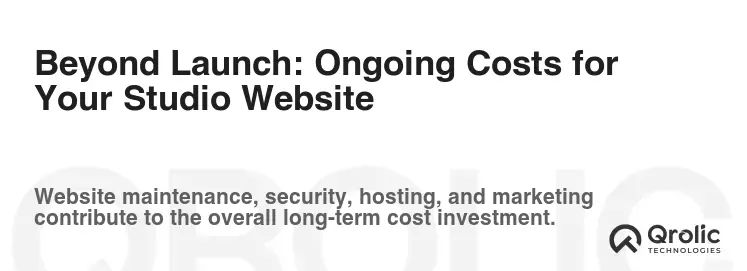
Your studio website cost doesn’t end the day it goes live. Like any valuable asset, it requires ongoing care and attention to remain effective and secure. Ignoring these can lead to security vulnerabilities, outdated content, and poor search engine performance.
Website Maintenance & Updates
What it is: Regularly updating your CMS (WordPress core, themes, plugins), checking for broken links, ensuring backups, monitoring security, and occasionally refreshing content.
Why it’s crucial: Outdated software is a security risk. Ignoring updates can lead to your site being hacked, breaking functionalities, or losing compatibility.
Cost:
- DIY: Your time, which has an inherent value.
- Freelancer/Agency Maintenance Plan: $50 – $500+ per month, depending on the complexity of your site and the scope of services (e.g., security monitoring, uptime checks, regular backups, minor content updates). This is a crucial aspect of overall website maintenance cost.
SEO & Digital Marketing
What it is: Continuous efforts to improve your website’s visibility in search engines and attract your target audience. This is vital for making your initial studio website cost investment worthwhile.
Cost: This can be a significant ongoing investment, but it’s directly tied to your growth.
- Content Marketing: Regularly creating valuable blog posts, articles, videos, or case studies. Can be done in-house (your time) or by hiring writers ($50 – $500+ per article).
- Local SEO: optimizing your Google My Business profile, getting local citations, and encouraging reviews. Crucial for any brick-and-mortar studio. Can be managed in-house or by a specialist agency ($200 – $1,000+ per month).
- Paid Advertising (Optional): Google Ads, social media ads (Facebook, Instagram, YouTube). Can range from $100s to $1,000s+ per month in ad spend, plus management fees if hiring an agency.
- Technical SEO Audits: Periodic checks for site health, speed, and other technical factors. Often part of maintenance plans or a separate service.
Licensing Fees
What it is: Annual subscriptions for premium themes, plugins, stock photos, fonts, or third-party services (like advanced booking systems or CRM tools).
Cost: Can range from $50 – $500+ per year, depending on the number and type of premium tools you use. These small recurring fees can add up.
Data Backup & Recovery Services
What it is: Ensuring your entire website (files and database) is regularly backed up and can be quickly restored in case of a disaster (hack, server crash, accidental deletion).
Cost: Often included with quality hosting or maintenance plans. Dedicated backup services can cost $10 – $50 per month. This is a non-negotiable insurance policy.
SSL Certificates
What it is: A security protocol that encrypts data transferred between your website and visitors’ browsers, indicated by https:// in the URL. Essential for security and SEO.
Cost: Many hosting providers now include a free SSL certificate (e.g., Let’s Encrypt). Premium certificates with higher warranties can cost $50 – $200 per year.
Budgeting for Your Studio Website in 2026: A Qrolic’s Guide

Let’s demystify the studio website cost by looking at common budget tiers. Remember, these are estimates, and your specific needs will tailor the final price.
The “Bare Bones” Budget (Under $1,000 Initial Investment)
What you get:
- Domain Name: ~$15/year
- Shared Hosting: ~$100/year
- DIY Website Builder (e.g., Squarespace, Wix): ~$240-480/year for a business plan, covering design, hosting, and basic features.
- Or: A very basic WordPress Site using a free theme, with you doing all the setup and content creation.
Who it’s for:
- New studios with extremely limited capital.
- Studios needing a simple online presence for contact info and a basic portfolio.
- Individuals comfortable with DIY website building and minimal customization.
- Someone testing the waters for a small studio website budget.
Limitations: Limited customization, potential for generic appearance, reliance on basic features, less scalability, and more of your time invested. You’ll likely outgrow this quickly if your studio thrives.
The “Growth-Focused” Budget ($1,000 – $5,000 Initial Investment)
What you get:
- Domain Name & Reliable Hosting: ~$150-300/year (potentially VPS or managed WordPress).
- Template-Based CMS Website (e.g., WordPress with a premium theme):
- Premium Theme: ~$60-150 (one-time)
- Essential Premium Plugins: ~$100-300/year (for booking, advanced SEO, security)
- Professional Setup & Customization: Hiring a freelancer or smaller agency to configure the theme, install essential plugins, and populate content. This includes tailoring the design to your brand, setting up a good photography studio website gallery or a dance studio website schedule, and basic SEO.
Who it’s for:
- Most small to medium-sized studios looking for a professional, functional website that stands out.
- Studios needing key features like online booking, a strong portfolio, or basic e-commerce.
- Those who want a good balance between cost and quality, recognizing the value of professional help.
- Studios aiming for sustainable growth and a solid foundation.
This tier often provides the best value, offering significant professional polish and functionality without the premium custom price tag.
The “Premium & Bespoke” Budget ($5,000 – $20,000+ Initial Investment)
What you get:
- Dedicated Hosting/Robust Managed Solution: ~$300 – $1,000+/year.
- Custom Design & Development: Hiring a reputable web agency (like Qrolic) or experienced senior freelancers for a truly bespoke website.
- Includes in-depth discovery, wireframing, custom UI/UX design, custom coding for unique features, advanced integrations (CRM, payment gateways, custom booking systems), robust security, and comprehensive SEO for studios implementation.
- Think sophisticated music studio websites with unique artist portals or high-end art galleries with interactive virtual experiences.
Who it’s for:
- Established studios with a strong brand identity and unique operational needs.
- Studios requiring highly specific functionalities not available off-the-shelf.
- Businesses aiming for a dominant online presence and a competitive edge.
- Those ready to make a significant investment for long-term growth and scalability.
Limitations: Higher upfront cost, longer development timeline. However, the custom solution is tailored precisely to your vision and can evolve with your business without limitations.
Cost-Saving Strategies Without Compromising Quality
- Prioritize Features: Don’t try to build everything at once. Identify your “must-have” features for launch and plan “nice-to-have” features for future phases.
- Phased Development: Launch a lean, functional website first (Phase 1) and then gradually add more complex features (Phase 2, Phase 3). This helps manage cash flow and test market response.
- Provide Quality Content Yourself: Writing your own copy, gathering high-resolution images, and organizing your portfolio can save development time.
- Leverage Open-Source CMS: Using platforms like WordPress, Joomla, or Drupal with well-supported themes and plugins can significantly reduce custom coding costs compared to building from scratch.
- Negotiate and Get Multiple Quotes: Don’t settle for the first quote. Compare proposals from different freelancers and agencies to understand the market rate and what’s included.
- Focus on Long-Term Value: Sometimes, spending a bit more upfront on quality design and robust development prevents costly fixes and redesigns down the line. A cheaper site isn’t always a cheaper studio website cost in the long run.
Choosing the Right Partner: Freelancer vs. Agency vs. DIY
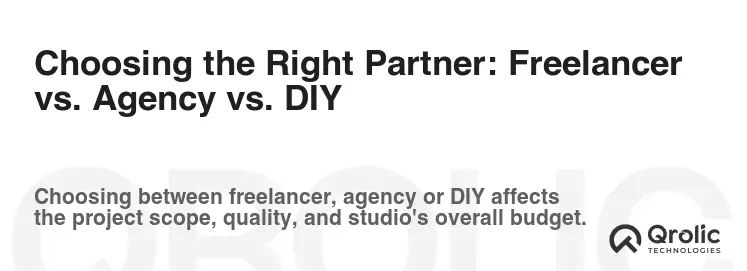
Deciding who will build your website is as important as setting your budget. Each option has distinct advantages and disadvantages when considering your studio website cost and desired outcome.
DIY: Control & Cost Savings, But Time & Skill Investment
- Pros: Maximum control, lowest monetary cost, immediate updates. You learn a valuable skill.
- Cons: Significant time investment, requires design aptitude and technical patience. Limited by your own skills and the platform’s constraints. If something breaks, you’re the IT support.
- Best for: Very small, new studios with minimal requirements, a tight small studio website budget, and owners who enjoy technical challenges.
Freelancers: Flexibility & Personal Touch, But Limited Scope
- Pros: Often more affordable than agencies, direct communication, personalized service, flexibility in project scope.
- Cons: Limited availability (one person), may lack specialized skills in all areas (design, development, SEO, marketing), potential for project delays if they get sick or overbooked, less formal support structure.
- Best for: Studios with a clear vision and defined project scope, comfortable working closely with one individual, and those seeking a good balance of cost and expertise for a specific project like a photography studio website portfolio.
Web Agencies: Comprehensive Solutions & Expertise, But Higher Cost
- Pros: Team of specialists (designers, developers, SEO experts, copywriters, project managers), comprehensive services from strategy to launch and ongoing support, robust project management, higher reliability, and ability to handle complex projects. Consistent support structure.
- Cons: Higher studio website cost compared to freelancers, potentially less direct communication with the actual developer, may have more rigid processes.
- Best for: Medium to large studios, those needing a full-service solution, complex websites with unique features, and businesses that value long-term partnership and dedicated support. Ideal for a professional studio website that needs to scale.
What to Look For in a Web Development Partner (Freelancer or Agency)
When evaluating potential partners, ask these crucial questions to ensure your studio website cost is well-spent:
- Portfolio & Experience: Do they have experience building websites for studios or similar businesses? Can they show relevant examples?
- Process & Communication: What’s their development process? How do they handle feedback? What are their communication channels?
- Transparency in Pricing: Is their quote detailed, breaking down costs for design, development, features, and ongoing maintenance? Are there any hidden fees?
- Technical Expertise: Are they proficient in the technologies relevant to your needs (e.g., WordPress, specific booking integrations, e-commerce platforms)?
- SEO Knowledge: Do they understand SEO for studios and how to build a site that ranks well?
- Post-Launch Support: What kind of maintenance, updates, and troubleshooting support do they offer after the site goes live?
- Client Testimonials & Reviews: What do previous clients say about their work, professionalism, and reliability?
- Scalability: Can the website they build grow with your studio, or will you need a complete overhaul in a few years?
Qrolic Technologies: Your Partner in Crafting an Impactful Studio Website
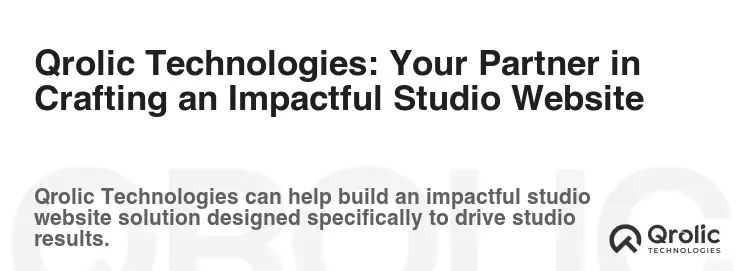
At Qrolic Technologies, we understand that your studio isn’t just a business; it’s a passion, a creative space, and a community hub. We believe your online presence should reflect that passion and drive your growth, without becoming a financial burden. We’ve honed our craft over years, perfecting the balance between stunning design, robust functionality, and cost-effective solutions for businesses just like yours. We navigate the complexities of studio website cost so you don’t have to.
Who is Qrolic?
Qrolic Technologies is a leading web development company dedicated to creating impactful, user-centric, and SEO-optimized digital experiences. We pride ourselves on transparent communication, innovative solutions, and a deep understanding of what makes a website not just look good, but also perform brilliantly. Our team of seasoned designers, developers, and digital strategists works collaboratively to bring your vision to life.
Our Approach to Studio Websites
We don’t believe in one-size-fits-all solutions. Our approach begins with truly understanding your studio’s unique identity, target audience, and business goals.
- Discovery & Strategy: We start by listening. What kind of studio do you run (photography, dance, music, yoga, art)? Who are your ideal clients? What specific problems do you need your website to solve?
- Tailored Design: Our designers craft a visually stunning and intuitive user experience that captures the essence of your studio, whether it’s the elegance of a yoga studio website or the dynamic energy of a dance studio website.
- Robust Development: Our developers build a secure, fast, and scalable website using the latest technologies, ensuring seamless functionality for everything from online booking to client portals.
- SEO Integration: We build with SEO in mind from day one, laying the groundwork for your studio to rank high in search results and attract organic traffic.
- Ongoing Partnership: We don’t just build and disappear. We offer comprehensive post-launch support and maintenance plans to ensure your website remains updated, secure, and performs optimally.
Why Choose Qrolic for Your Studio
- Expertise in Studio Needs: We have extensive experience with businesses that thrive on visual appeal, community, and streamlined booking, understanding the unique requirements of photography studio websites, music studio websites, and all other creative ventures.
- Cost-Efficiency & Transparency: We provide detailed quotes, breaking down every aspect of your studio website cost, so you know exactly where your investment is going. We strive to deliver maximum value within your budget.
- Future-Proofing: Our solutions are built to be scalable and adaptable, meaning your website can grow and evolve alongside your studio without requiring costly rebuilds every few years.
- Dedicated Support: Our team is always ready to assist you, offering prompt and reliable support to ensure your website runs smoothly.
- Focus on ROI: We don’t just build websites; we build digital assets that generate leads, streamline operations, and enhance your brand’s reputation, ensuring a strong return on your professional studio website pricing investment.
Services Relevant to Studio Websites
- Custom Website Design & Development: Crafting unique, brand-aligned websites from scratch.
- CMS Development (e.g., WordPress): Leveraging flexible platforms for cost-effective, powerful solutions.
- Online Booking & Scheduling Integration: Implementing seamless systems for appointments, classes, and sessions.
- E-commerce Solutions: Setting up online stores for merchandise, digital products, or workshops.
- Portfolio & Gallery Design: Stunning visual showcases for your creative work.
- SEO Optimization: Ensuring your studio ranks high in local and broader search results.
- Website Maintenance & Security: Keeping your site safe, fast, and up-to-date.
- Mobile Responsiveness: Guaranteeing an optimal experience on all devices.
Realizing Your Vision with Qrolic
Ready to transform your studio’s online presence? Visit our website at https://qrolic.com/ to explore our portfolio and get a personalized quote for your studio website cost. Let’s build a digital home for your studio that truly shines and drives your success in 2026 and beyond.
Actionable Steps: Your Studio Website Journey in 2026

Feeling overwhelmed by the studio website cost and the myriad of options? Let’s break down your journey into manageable, actionable steps.
Step 1: Define Your Goals & Audience
- What do you want your website to achieve? (e.g., attract new clients, facilitate online bookings, showcase portfolio, sell products, build a community).
- Who is your target audience? (e.g., aspiring artists, professional musicians, health-conscious individuals, parents of young dancers). Understanding them will influence design and features.
- What makes your studio unique? (Your brand identity, values, special offerings).
Step 2: Research & Gather Inspiration
- Look at competitors’ websites and other studios you admire. What do you like? What do you dislike?
- Note specific features, layouts, color schemes, and content styles that resonate with your vision.
- Create a “mood board” of ideas to share with your chosen developer.
Step 3: Outline Your Desired Features
Based on your goals, make a list of must-have and nice-to-have features.
- Must-haves: Online booking, portfolio, contact form, mobile responsiveness.
- Nice-to-haves: Blog, e-commerce, client portal, live chat. This will directly impact your studio website cost.
Step 4: Set Your Budget (Realistically)
Based on our guide:
- Determine your initial investment comfort level. Can you afford the “Bare Bones,” “Growth-Focused,” or “Premium & Bespoke” tier?
- Factor in ongoing costs: Hosting, domain, maintenance, and potential marketing. Don’t forget these; they are crucial to long-term success.
- Be flexible: Websites are investments; allow for some wiggle room.
Step 5: Choose Your Development Path
- DIY: If your budget is minimal and you have time and basic design skills.
- Freelancer: For specific projects, clear requirements, and a more personal touch.
- Web Agency (like Qrolic): For comprehensive solutions, complex features, long-term partnerships, and peace of mind.
Step 6: Plan for Ongoing Success
- Content Strategy: How will you keep your website fresh with new blogs, portfolio updates, or class schedules?
- Marketing Plan: How will you drive traffic to your site (SEO, social media, ads)?
- Maintenance Schedule: Ensure regular updates and security checks.
- Analytics Review: Regularly check your website analytics (Google Analytics) to understand visitor behavior and identify areas for improvement.
Future-Proofing Your Studio Website: Trends for 2026 and Beyond
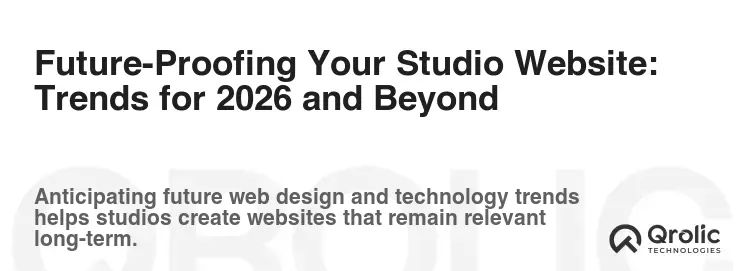
The digital landscape is ever-evolving. While considering your current studio website cost, it’s wise to cast an eye towards the future to ensure your investment remains relevant.
AI Integration
Expect more personalized experiences driven by AI. Think AI-powered chatbots for instant customer support, personalized class recommendations based on user history, or AI-generated content suggestions for your blog. This can elevate the user experience significantly.
Voice Search Optimization
As voice assistants become ubiquitous, optimizing your content for voice queries (“Hey Google, find a yoga studio near me”) will be crucial. This means natural language, conversational content, and local SEO focus.
Enhanced Personalization
Your website will adapt to individual visitors more profoundly. Displaying specific class schedules based on a user’s location, showing tailored portfolio pieces, or remembering past preferences will create a more engaging and sticky experience.
Immersive Experiences (VR/AR for Tours, Virtual Classes)
For creative studios, imagine virtual reality tours of your facility, augmented reality overlays on your artwork, or fully immersive virtual classes that transcend physical boundaries. While this will impact professional studio website pricing, it offers unparalleled engagement.
Core Web Vitals and User Experience as Paramount
Google continues to emphasize Core Web Vitals (loading speed, interactivity, visual stability). A fast, fluid, and intuitive user experience isn’t just a nicety; it’s a critical ranking factor and a driver of conversion.
Sustainability in Web Design
As environmental awareness grows, “green hosting” and efficient web design practices (reducing data transfer, optimizing images) will become more prominent, reflecting a studio’s commitment to sustainability.
The ROI of a Professional Studio Website: It’s an Investment, Not an Expense
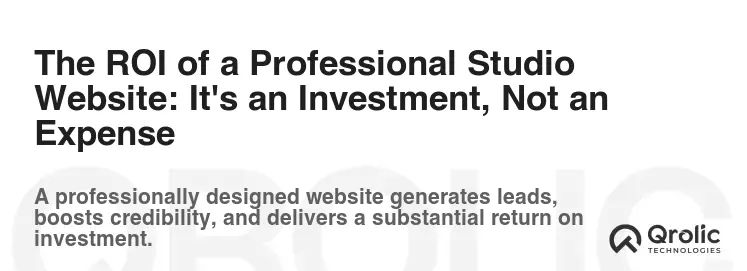
When you look at the studio website cost, it’s easy to see it as a significant expense. However, shift your perspective: a well-executed professional website is a strategic investment that yields substantial returns.
Increased Bookings & Revenue
This is the most direct return. A professional website with seamless online booking and a compelling portfolio directly leads to more clients signing up for classes, sessions, or purchasing products. Every successful conversion is a direct recouping of your studio website cost.
Enhanced Brand Authority & Trust
A high-quality website positions your studio as an industry leader. It builds authority, instills trust, and reinforces your brand’s professionalism, making clients more likely to choose you over competitors with lesser online presences.
Operational Efficiency
By automating bookings, payments, and inquiries, your website frees up your time and resources, allowing you to focus on your core creative work. This efficiency, though harder to quantify, saves you money and stress in the long run.
Competitive Advantage
In a crowded market, a superior website can be your key differentiator. It allows you to showcase your unique value proposition, attract your ideal client, and stay ahead of the curve. Your website isn’t just about competing; it’s about leading.
Final Thoughts: Your Studio’s Digital Frontier Awaits
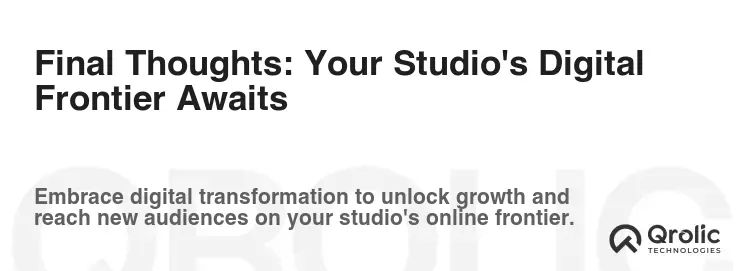
The journey of establishing your studio’s online presence in 2026 is exciting and filled with potential. Understanding the studio website cost is merely the beginning. What truly matters is the strategic vision behind that investment. A well-designed, functional, and thoughtfully maintained website is more than just a digital placeholder; it’s your most powerful marketing tool, your 24/7 sales team, and the digital heart of your studio.
Embrace this opportunity. Define your vision, plan your budget, choose the right partner, and prepare to unlock a world of growth and connection. Your studio’s digital frontier awaits, ready to welcome new clients and elevate your brand to unprecedented heights.







